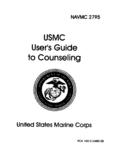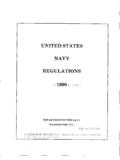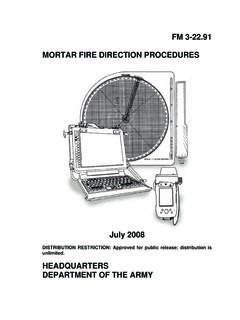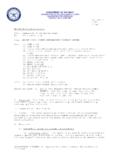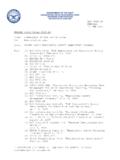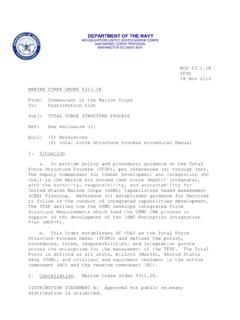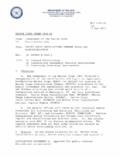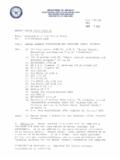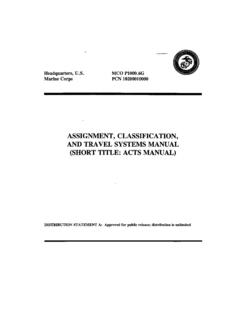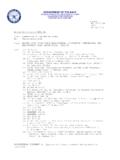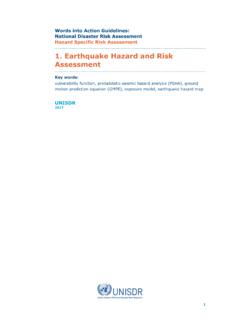Transcription of U.S. Marine Operations in Korea Vol 5 1950 - 1953 PCN ...
1 SOUTHKO1 EAFWESTERN KOREAN FRONTSITES OF MAJOR OUTPOST BATTLESVCOPI1952-53 MUNSAN-NIU . S. Marine Operations IN KOREA1950 1953 VOLUMEVO perations in West KoreabyLIEUTENANT COLONEL PAT MEID, USMCRandMAJOR JAMES M. YINGLING, USMCH istorical DivisionHeadquarters, U. S. Marine CorpsWashington,D . C., 1972 Preceding Volumes ofU. S . Marine Operations in KoreaVolume I, "The Pusan Perimeter"Volume II, "The Inchon-Seoul Campaign"Volume III, "The Chosin Reservoir Campaign"Volume IV, "The East-Central Front"P CN19000264000 Library of Congress catalogue Number:55-60727 For Sale by the Superintendent of . Government Printing OfficeWashington, 20402 Price $ (Cloth)Stock Number 0855-0059 ForewordMENTION THE KOREAN WARand almost immediately it evokesthe memory of Marines at Pusan, Inchon, Chosin Reservoir,or the Punchbowl.
2 Americans everywhere remember the MarineCorps' combat readiness, courage, and military skills that werelargely responsible for the success of these early Operations in1950-1951. Not as dramatic or well-known are the important ac-complishments of the Marines during the latter part of the March 1952 the 1st Marine Division redeployed from the East-Central front to West Korea . This new sector, nearly 35 miles inlength, anchored the far western end of I Corps and was one ofthe most critical of the entire Eighth Army line. Here the Marinesblocked the enemy's goal of penetrating to Seoul, the South Koreancapital. Northwest of the Marine Main Line of Resistance, less thanfive miles distant, lay Panmunjom, site of the sporadic truce of their strategic area exposed the Marines to continuousand deadly Communist probes and limited objective attacks.
3 Thesebitter and costly contests for key outposts bore such names as BunkerHill, the Hook, the Nevadas (Carson-Reno-Vegas), and BoulderCity. For the ground Marines, supported by 1st Marine AircraftWing squadrons, the fighting continued until the last day of thewar, 27 July Korean War marked the first real test of Free World soli-darity in the face of Communist force. In repulsing this attemptedCommunist aggression, the United Nations, led by the United States,served notice that it would not hesitate to aid those nations whosefreedom and independence were under events have subsequently proven, holding the line againstCommunist encroachment is a battle whose end is not yet in aggression may explode brazenly upon the world scene, withan overt act of invasion, as it did in Korea in June 1950, or it mayIIIiv Forewordtake the form of a murderous guerrilla war as it has more recently,for over a decade, in guise the enemy of the United States chooses or wher-ever he draws his battleline, he will find the Marines with their age-old answer.
4 Today, as in the Korean era, Marine Corps readiness andprofessionalism are prepared to apply the cutting edge against anythreat to American . F. CHAPMAN, , Marine Corps,Commandant of the Marine CorpsReviewed and approved: 12 May IS THE CONCLUDINGVOLUMEof a five-part series dealing withoperations of United States Marines in Korea between 2 August1950 and 27 July 1953. Volume V provides a definitive account ofoperations of the 1st Marine Division and the 1st Marine AircraftWing during 1952-1953, the final phase of the Korean War. At thistime the division operated under Eighth . Army in Korea (EUSAK)control in the far western sector of I Corps, while Marine aviatorsand squadrons functioned as a component of the Fifth Air Force(FAF).The period covered by this history begins in March 1952, whenthe Marine division moved west to occupy positions defending theapproaches to Seoul, the South Korean capital: As it had for most ofthe war the 1st Marine Aircraft Wing, operating under FAF, flewclose support missions not only for the Marines but for as many as19 other Allied frontline divisions.
5 Included in the narrative isadetailed account of Marine POWs, a discussion of the new defensemission of Marine units in the immediate postwar period, and anevaluation of Marine Corps contributions to the Korean , both ground and aviation, comprised an integral part ofthe United Nations Command in Korea . Since this is primarilyaMarine Corps history, actions of the Army, Navy, and Air Forceare presented only in sufficient detail to place Marine Operations intheir proper Marine Corps combat records form the basis for the primary source material has been further supplemented by com-ments and interviews from key participants in the action than 180 persons reviewed the draft chapters. Their technicalknowledge and advice have been invaluable. Although the full detailsof these comments could not be used in the text, this material hasbeen placed in Marine Corps archives for possible use by manuscript of this volume was prepared during the tenureof Colonel Frank C.
6 Caldwell, Director of Marine Corps History,vVI PrefaceHistorical Division, Headquarters Marine Corps. Production was ac-complished under the direction of Mr. Henry I. Shaw, Jr., DeputyDirector and Chief Historian, who also outlined the volume. Pre-liminary drafts were written by the late Lynn Montross, prime authorof this series, and Major Hubard D. Kuokka. Major James researched and wrote chapters 1 6 and compiled theCommand and Staff List. Lieutenant Colonel Pat Meid researchedand wrote chapters 7-12, prepared appendices, processed photographsand maps, and did the final editing of the Division staff members, past or present, who freely lentsuggestions or provided information include Lieutenant Colonel JohnJ . Cahill, Captain Charles B. Collins, Mr. Ralph W. Donnelly, M.
7 Frank, Mr. George W. Garand, Mr. Rowland P. Gill,Captain Robert J. Kane, Major Jack K. Ringler, and Major Lloyd Warrant Officer Dennis Egan was Administrative Officerduring the final stages of preparation and production of this many exacting administrative duties involved in processing thevolume from first draft manuscripts through the final printed form,including the formidable task of indexing the book, were handledexpertly and cheerfully by Miss Kay P. Sue. Mrs. Frances J. Rubrightalso furnished gracious and speedy assistance in obtaining the tomesof official Marine Corps records. The maps were prepared bySergeants Kenneth W. White and Ernest L. Wilson. Official Depart-ment of Defense photographs illustrate the major contribution to the history was made by the Office of theChief of Military History, Department of the Army; the NavalHistory Division, Department of the Navy; and the Office of AirForce History, Department of the Air Force.
8 Military history officesof England, Canada, and South Korea provided additional detailsthat add to the accuracy and interest of this concluding volume ofthe Korean seriesF . C . CALDWELLC olonel, . Marine Corps (Retired)Director of Marine Corps HistoryContentsI Operations in West Korea Cairo to JAMESTOWN The Marines' Home in WestKorea Organization of the 1st Marine Division Area The 1st Marine Aircraft Wing The Enemy Initial CCFA ttack Subsequent CCF Attacks Strengthening the Line Marine Air Operations Supporting the Division and theWing Different Area, Different ProblemII Defending the Line UN Command Activities Defense of East and West CoastKorean Islands Marine Air Operations Spring1952onJAMESTOWN End of the Second Year of War A LongFourth of July Changes in the Lineup Replacement andRotation Logistical Operations .
9 Summer1952 III The Battle of Bunker Hill 103 The Participants and the Battlefield Preliminary Action onSiberia The Attack on Bunker Hill Consolidating theDefense of Bunker Hill Company B Returns to Bunker Hill Supporting Arms at Bunker Hill In RetrospectIVOutpost Fighting Expanded 145 From the Center Sector to the Right Early September Out-post Clashes Korean COPs Hit Again More Enemy As-saults in Late September Chinese Intensify Their OutpostAttacks More PRESSURE, More CAS, More Accomplish-ments Rockets, Resupply, and RadiosV The Hook 185 Before the Battle Preparations for Attack and Defense Attack on the Hook Reno Demonstration Counterattack OverviewVIPositional Warfare 217A Successful Korean Defense Six Months on the UNC Line Events on the Diplomatic Front The Marine CommandsPage151 VIIVlll ContentsDuring the Third Winter 1st MAW Operations 1952 1953 Behind the Lines The Quiet Sectors Changes in theConcept of Ground Defense Before the Nevadas BattleVII Vegas The Nevada Cities Supporting Arms Defense Organiza-tion at the Outposts Chinese Attack on 26 March Rein-forcements Dispatched Massed Counterattack the Next Day Push to the Summit Other Communist Probes ThreeCCF Attempts for the Outpost Vegas Consolidation Be-gins AftermathVIII Marking Time (April June 1953).
10 31 3 The Peace Talks Resume OperationLITTLESWITCH Inter-val Before the Marines Go Off the Line The May Relief TrainingWhile in Reserve and Division Change of Com-mand Heavy May June Fighting Developments in MarineAir Other Marine Defense Activities The Division IsOrdered Back to the FrontIX Heavy Fighting Before the Armistice 36 3 Relief of the 25th Division Initial Attacks on OutpostsBerlin and East Berlin Enemy Probes, 11 18 July MarineAir Operations Fall of the Berlins Renewal of HeavyFighting, 24 26 July Last Day of the WarX Return of the Prisoners of War 39 9 OperationBIGSWITCH Circumstances of Capture TheCommunist POW Camps CCF "Lenient Policy" and In-doctrination Attempts The Germ Warfare Issue Problemsand Performance of Marine POWs Marine Escape Attempts Evaluation and AftermathXI While Guns Cool 445 The Postwar Transition Control of the DMZ and the Mili-tary Police Company Organization of New Defense Posi-tions Postwar Employment of Marine Units inFECOMXII Korean Reflection 47 5 Marine Corps Role and Contributions to the Korean War.
